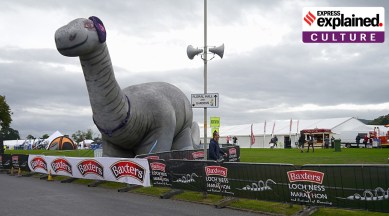Finding ‘Nessie’: The enduring legend of the Loch Ness monster
Monster hunters have gathered in northern Scotland this weekend for what is being described as the biggest search for the Loch Ness monster in 50 years.

There are few creatures in history to have fascinated humans as much as the Loch Ness monster. Affectionately called Nessie, the monster is a creature in Scottish folklore, believed to live in the stygian depths of the Loch (lake in Scottish) Ness, in the Scottish Highlands.
Over the years, Nessie has drawn thousands of monster hunters to Scottish shores, has had multiple claimed sightings, and become an enduring symbol in popular culture. Yet definitive proof of Nessie’s existence has been elusive, with many famous ‘findings’ ultimately turning out to be hoaxes.
“The weekend gives an opportunity to search the waters in a way that has never been done before, and we can’t wait to see what we find,” Loch Ness Center manager Paul Nixon said.
Here, we look at the enduring legend of the Loch Ness monster and how it captured imaginations across the world.
First mention in the 6th century AD
Loch Ness is the United Kingdom’s largest lake by volume, at 36 km long and with a maximum depth of 240 m. It lies approximately 37 km south of Inverness and nearly 300 km from Glasgow. Notably, its water is really murky with visibility exceptionally low due to the high peat content in the surrounding soil.
Nessie made its first recorded appearance in the biography of Saint Columba, a Catholic missionary from Ireland who travelled to Scottish shores to preach and proselytise. His account recounts the burial of a man who had been killed by a “water beast”. When the monster returned to attack another swimmer in River Ness, which flows from the lake, Saint Columba, as per his biography, made the sign of the cross, causing the beast to swim away.
Over the years, the Loch Ness monster became a recurring fixture in Scottish folklore, with the earliest depiction of its form dated to the 12th century. Notably, unlike the more modern dinosaur-like representation, this 12th century painting portrays it as similar to being a bear.
Nessie becomes a global phenomenon
“Wherever the poetry of myth is interpreted as biography, history, or science, it is killed,” Joseph Campbell wrote in his highly influential The Hero with a Thousand Faces (1949). In many ways, the myth of the Loch Ness monster defies this axiom.
While many myths have died down, or been mundanely explained in the ‘Age of Reason’, the legend of the Loch Ness monster only grew exponentially in the 20th century. In 1933, a local newspaper, The Inverness Courier, reported a couple sighting a “fearsome-looking monster” as they were driving along the loch.
This was followed by a flurry of sightings that British tabloids milked for what they were worth. In 1934, the Daily Mail published the now famous photo of the Loch Ness monster, bringing global attention to Nessie. While later revealed to be a hoax, the grainy black and white image continues to inspire conspiracy theorists across the world.
In 1934, the photo prompted what is recognised as the first organised search for the Loch Ness monster when a rich businessman sent 20 people armed with Kodak cameras and field glasses to watch the loch. The crew reportedly sighted Nessie 22 times.
Till date, as per the Loch Ness Center, there have been 1,100 officially recorded sightings of the monster.
Large-scale investigations yield no evidence
In 1976, an extremely well-funded American investigation however, dampened the enthusiasm. Using underwater cameras and sonar equipment, the month-long search scoured the bottom of the lake for potential skeletons and carcasses. It yielded nothing.
An even bigger expedition in 1987 also found no new evidence to explain the Loch Ness monster. Neither did a 2003 search by the BBC. Notably, during its search, the BBC also carried out an experiment on visiting tourists. It placed a fence-like structure underwater, and as tourist boats drew near, it slowly raised it to catch tourists’ eyes. It found that many onlookers later reported seeing “monster-shaped heads”.
In 2018, a DNA survey conducted by a group of researchers on water samples collected from across the lake found no evidence of any large animals in Loch Ness, only detecting the presence of numerous eels. Professor Neil Gemmell who led the research told The NYT, “what people see and believe is the Loch Ness monster might be a giant eel.”
But, the legend endures.
In 2021, a scientific paper reported the discovery of plesiosaur fossils — teeth, vertebrae, and one humerus from a young juvenile — in what was once a freshwater river in Morocco. Plesiosaurs had till then known to be exclusively marine creatures.
Interestingly, this paper got a lot of attention among Nessie enthusiasts who claimed that this increased the plausibility of the presence of such an aquatic dinosaur in the freshwater Loch Ness. The media picked the story up and drummed up interest. This, is how the Loch Ness monster legend survives – through speculation and fascinating, yet ultimately futile, conspiracy-mongering.
It also endures, in no small part due to the workings of capitalism. Today, Nessie is commonly featured in Scottish memorabilia and the legend of the monster is also a driver for the tourism industry.
In the wake of the latest search, hotels along the loch are packed and business is thriving. Fraser Campbell, director of the Cobbs Group, which owns hotels and restaurants along the western shore of the loch, told The Guardian that the renewed interest in the monster legend had led to “unbelievable” bookings across this summer season.